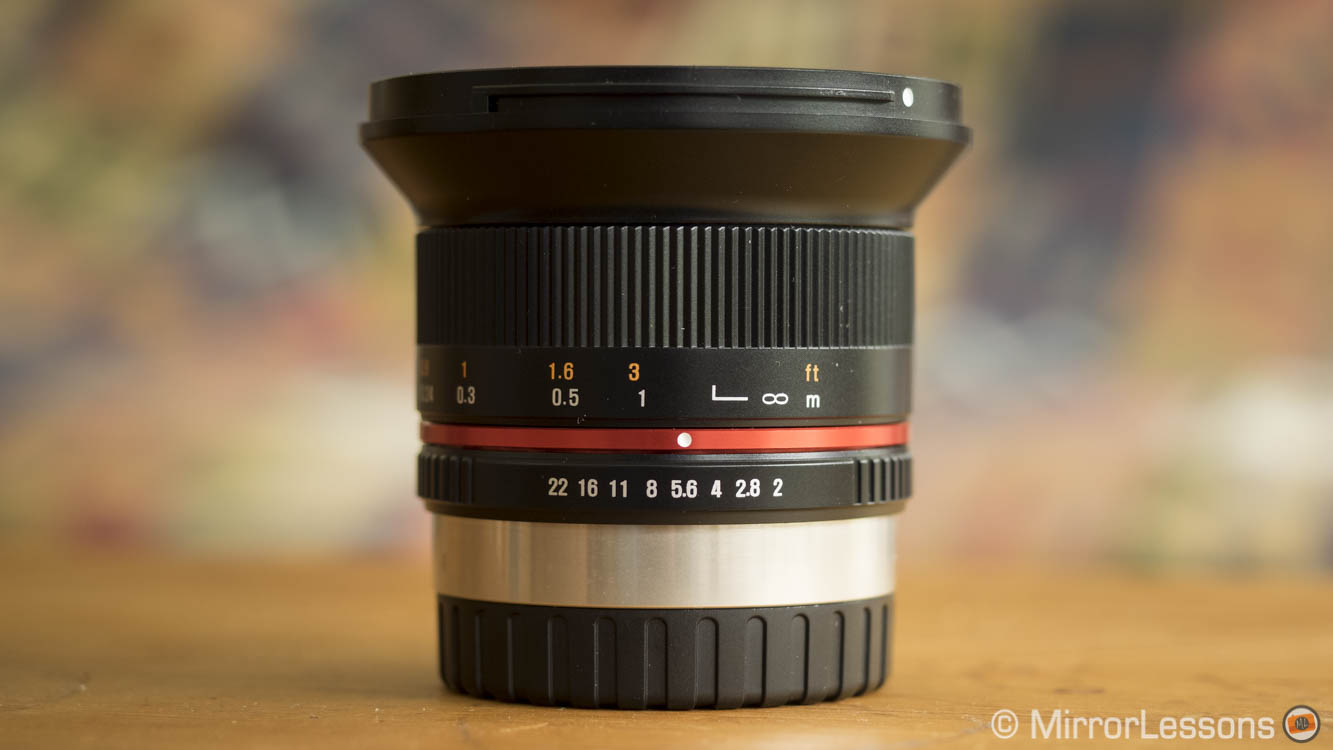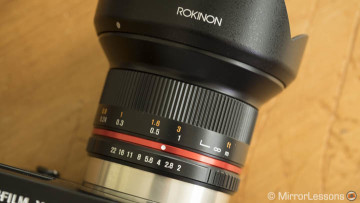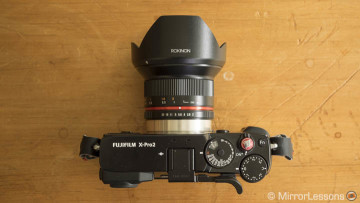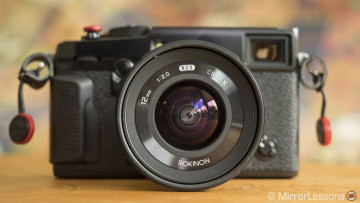Over the past few months, we have been sharing numerous articles that focus on Samyang CS lenses designed for mirrorless cameras. In the specific CS category, there is one lens that we cannot skip even though it is no longer new: the 12mm f/2. It is one of the best deals you can find for your mirrorless APS-C camera. So even though the product is now two years old, we felt that it was about time to included on our review list. As the expression goes: better later than never!
Is the 12mm f/2 still a valid option two years on from its release? Let’s find out!
Note: The 12mm f/2 is available for Fuji X, Sony E, Canon M, Samsung NX and Micro Four Thirds mounts. In this article I’ll be reviewing the X-mount version but the optical quality is the same for all versions. The lens is designed for APS-C sensors and will give you an equivalent 24mm field of view (35mm format terms) on a m4/3 camera. In some areas, the lens is sold with the Rokinon name.

- Mount: Fuji X, Sony E, Canon M, Samsung NX, micro four thirds
- Format coverage: APS-C
- Focal length: 12mm
- Focal length (equiv. 35mm): 18mm
- Maximum aperture: 2
- Minimum aperture: 22
- Number of aperture blades: 6 circular aperture blades
- Angle of view: 98.9°
- Closest focusing distance: 20cm
- Lens configuration: 10 elements / 10 groups
- Special elements: 1 aspherical, 1 hybrid aspherical and 3 ED elements
- Lens surface coating: Yes (Nano Coating)
- Optical Image Stabilizer: None
- Dimensions: ø72.5 x 59.4 mm
- Filter diamater: ø67mm
- Weight: 260g
Table of Contents
Design and ease of use
Like the other lenses in the series, the 12mm is small and light with a weight of only 260g. The construction is metal with a plastic finish on the surface, except for the part near the mount where the silver metal is revealed. The lens doesn’t feature weather sealing and lacks optical stabilisation.

The aperture ring moves in 1/2 steps with good precision. The focus ring is a little stiff to turn but I wasn’t annoyed by it. Samyang probably designed it that way to make sure that the ring doesn’t turn accidentally when shooting landscapes or astro-photography. I consider this a positive thing. Plus it is unlikely you will need to rotate it all the time. Given the wide angle of view, using zone focusing is easy and you will get everything in focus most of the time unless you are focusing at short distances.
One minor complaint that I mentioned in my other two Samyang reviews is the lack of a proper hyperfocal scale, which would expected on a manual focus lens.
There are no electronic contacts on the rear so no data is transmitted to the camera: the focal length and aperture used won’t be recorded in the EXIF data. With Fujifilm cameras, a partial workaround is to use the Mount adaptor settings and select the focal length manually.
Through the lens: optical quality
The Samyang 12mm gives you the equivalent field of view of an 18mm lens for full-frame cameras (35m format). It’s a good middle ground between an ultra wide angle and a moderate wide angle.
The lens provides excellent sharpness at the centre. At f/2 the result is already excellent. You can get some shallow depth of field and a decent bokeh when shooting at the minimum focus distance (20cm) but I doubt you will use the lens this way. The fast aperture is meant to help photographers in low light and for astro-photography really.

Click to open the full res version
Peak sharpness is found between f/4 and f/5.6 at short and long focus distances. From f/11 you start to lose some detail because of diffraction and it becomes more severe at f/16 and f/22.


The corners are noticeably softer than the centre at f/2 but improve from f/4. The lens is a good choice for landscapes but bear in mind that the corners will never be as sharp as the center.

Vignetting is more noticeable at f/2 but you get some even at smaller apertures like f/5.6. Barrel distortion is also present but can be easily corrected with the lens profile in Lightroom/Camera RAW. Note that it won’t be corrected in the SOOC JPG because of the lack of EXIF data. The lens proved a good companion for architecture shots both indoors and out.

Chromatic aberration is present at the fastest apertures and you can find traces also at smaller apertures like f/8, especially in the corners. Once again you will need a RAW post processing software to get rid of it but it can be tricky to make it disappear completely.

Click to open the full res version

Flare can appear in the form of small ghost flares in direct sunlight like in the example below.

Unfortunately I wasn’t able to put the lens to the test for one of its strongest point: astro-photography. During my time with it, the weather was consistently cloudy at night. That said, other reviews and galleries have shown that the 12mm is one of the best companions you can find for this genre. If you are interested in knowing more, I suggest reading the excellent review at Lonely Speck.
Conclusion
The Samyang / Rokinon 12mm f/2 is a good example of how a lens can be a good investment, no matter how old it is. The 12mm is a great match for the latest cameras like the Fuji X-Pro2, X-T2 and Sony a6300. You can find it for an average of $300 and it’s worth every penny.
Sharpness is already excellent at the centre from f/2 and becomes good from f/4 in the corners. The lens itself is compact and light, and is an excellent companion for landscapes, architecture and astro-photography. It’s a great product to own, not just for photographers on a budget but any user who owns an APS-C mirrorless camera.
 What I like about the Samyang 12mm f/2 NCS CS:
What I like about the Samyang 12mm f/2 NCS CS:
- Small and light
- Excellent sharpness at the centre at all apertures
- Good sharpness at the corners from f/4
 What I don’t like about the Samyang 12mm f/2 NCS CS:
What I don’t like about the Samyang 12mm f/2 NCS CS:
- Focus ring is a little bit stiff
- You will need manual CA correction in post-production
- No electronic contacts meaning no EXIF data is recorded
Additional reads:
- Chasing light in Cornwall – Image gallery
- Samyang / Rokinon 21mm f/1.4 review
- Samyang / Rokinon 50mm f/1.2 review
Additional images

Click on the image to open the full res version

Click on the image to open the full res version

Click on the image to open the full res version

Click on the image to open the full res version

Click on the image to open the full res version

Click on the image to open the full res version

Click on the image to open the full res version









Wish you had tested the MFT version too. The 24 eq fov is a significant difference and sharpness should also be affected by the different crop.
No problem. You could delete this thread if you wish. I figured it was a copy/paste issue. 🙂 LOVE your reviews, Mathieu and Heather!
Thanks, wrong copy and paste I guess 🙂
Oops! Thanks for noticing!
” One minor complaint that I mentioned in my other two “Samsung” reviews … ”
😉
Nice review, but for the things you don’t like about this lens, you listed the 21 mm F1 .4.
Great shot Michael!
It’s a shame I didn’t get the chance to use it for astro-photography during my testing period.
I have a Samyang 12mm for the Fujifilm X-mount. It pretty much lives permanently on my Fujifilm X-E1, since this camera is well suited to a manual focus lens. I purchased it for astrophotography and it truly excels in this role. Sharp to the corners at f/2 with little diffraction or chromatic aberration. However, after viewing your imagestaken with this lens as daylight landscapes, I understand that I am really under utilizing it’s abilities. I will need to get out there and point it at some vistas!